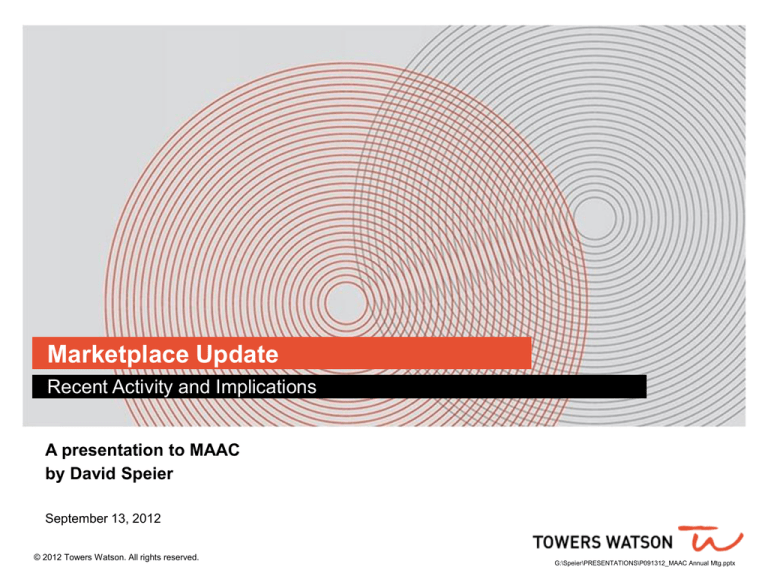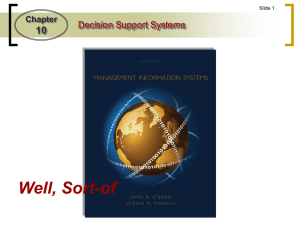
Marketplace Update
Recent Activity and Implications
A presentation to MAAC
by David Speier
September 13, 2012
© 2012 Towers Watson. All rights reserved.
G:\Speier\PRESENTATIONS\P091312_MAAC Annual Mtg.pptx
GM Announcement
On June 1st, GM announced that it intends to settle $26 billion in salaried
retiree obligations by the end of 2012
Retirees who retired after 10/1/1997 would receive an offer for a lump-sum to be
paid by end of August, 2012 (approximately 55% of retiree obligations)
Employees and terminated vested participants would be spun-off into a
separate plan
Retiree-only plan would be put through a standard plan termination process
Annuity would be purchased from Prudential on behalf of remaining retirees
Reported financial impact:
Settle $26 billion in retiree obligations for $29 billion
Additional contributions of $4 billion
One-time P&L charge of $3 billion, and reduction in pension income of $200
million annually
Increased financial flexibility
towerswatson.com
© 2012 Towers Watson. All rights reserved. Proprietary and Confidential. For Towers Watson and Towers Watson client use only.
G:\Speier\PRESENTATIONS\P091312_MAAC Annual Mtg.pptx
1
Current Marketplace
Ford vs. GM: Comparison of De-Risking Action*
Type
Ford
GM
Plans Closed to New Entrants
Yes
Yes
Ongoing Benefit Accruals Frozen
No
Yes
Asset Based
Liability Driven Investment (LDI) Strategy
Yes
Yes
Settlement Based
Prospective Lump Sum Option
Yes
Yes
TV One-Time Lump Sum Offer
Yes (~30,000)
No
Retiree Lump Sum Offer
Yes (~66,000)
Yes (~42,000)
Retiree Annuity Purchase
No
Yes (~100,000)
Estimated Liabilities Settled
$5B
$26B
End of 2013
End of 2012
Plan Design
Action
Settlement Date
* Note: All data provided based on publically available information
towerswatson.com
© 2012 Towers Watson. All rights reserved. Proprietary and Confidential. For Towers Watson and Towers Watson client use only.
G:\Speier\PRESENTATIONS\P091312_MAAC Annual Mtg.pptx
2
Pension Risk Management Aligns All Key Levers
Effective at managing
active liability risk profile
and long-term plan cost
Effective at managing
size of plan and overall
risk exposure
Effective only for shortterm issues and cost
recognition timing
towerswatson.com
BENEFIT
STRATEGY
Effective at managing
long-term plan cost
and volatility
INVESTMENT
STRATEGY
LIABILITY
TRANSFER/
EXIT
STRATEGY
FUNDING
STRATEGY
Effective at managing
short-term plan cost
and volatility
ASSUMPTIONS
AND METHODS
© 2012 Towers Watson. All rights reserved. Proprietary and Confidential. For Towers Watson and Towers Watson client use only.
G:\Speier\PRESENTATIONS\P091312_MAAC Annual Mtg.pptx
3
Lump Sum – Opportunity for 2012
Many plans reset interest rates on an annual basis,
using a permitted “look-back” to a date up to 5
months prior to the start of the year
Due to declines in interest rates since August 2011,
many companies can offer lump sums in 2012 on a
favorable basis (i.e., relative to plan liabilities)
TV lump sums could be 5% - 20% lower; retiree lump
sums could be 3-5% lower
Value of accelerated lump sum windows will vary
with market rates, thus illustrating the impact of
preparation and monitoring
Estimated Lump Sum Rates Payable in 2012
Terminated
Vested Age 45
Retiree Age 65
August 2011
6.02%
4.66%
September 2011
5.80%
4.54%
October 2011
5.50%
4.54%
November 2011
5.26%
4.43%
December 2011
5.24%
4.42%
May 2012 Rates*
4.99 %
4.10%
Look-back Month
* Estimated May segment rates based on April, 2012 segment rates and
average yield change during May
towerswatson.com
© 2012 Towers Watson. All rights reserved. Proprietary and Confidential. For Towers Watson and Towers Watson client use only.
G:\Speier\PRESENTATIONS\P091312_MAAC Annual Mtg.pptx
4
If Not 2012, When?
Falling rates in 2012
suggest value in
accelerating lump sum
window
Windows not opened in
2012 unlikely to be
opened in 2013 (unless
rates rise in 2012)
Sponsors not moving
forward are faced with at
least 2 more years of
financial risk and operating
expense
The following would need to occur to imply waiting until 2014 (or beyond) is
economically preferable to offering lump sums in 2012
Rates rise enough to get back to 2011 levels plus enough to cover 2 years of
operating cost and liability growth
Depending on plan profile, this could require 50-200bps increase in rates
Plan sponsor would also need to be comfortable with the exposure to financial
risk during the delay period
Sponsors with moderate to high equity exposure (intended to outgrow assets) will
need to address annual volatility
Sponsors with high fixed income exposure will be less likely to outearn obligations,
thus increasing expected cost of implementation
towerswatson.com
© 2012 Towers Watson. All rights reserved. Proprietary and Confidential. For Towers Watson and Towers Watson client use only.
G:\Speier\PRESENTATIONS\P091312_MAAC Annual Mtg.pptx
5
Retiree Lump Sum Offer – Why or Why Not
In the absence of clear regulatory guidance on the permissibility of offering
lump sums to retirees, there are several questions that a sponsor can ask to
determine if the option could add enough value to warrant further
consideration
Why Explore Further?
Why Not Explore Further?
Plan is well funded
Plan is not well funded and additional contributions are
not available
Large retiree population
Relatively small obligations
Significant number of younger or recent retirees
A majority of retirees are older
Concerns about pricing of annuity purchase alternative
Concerns over anti-selection
Other risk management strategies have been addressed
or implemented
Other risk management options have not yet been
examined or implemented
Desire to provide increased retirement income flexibility to
participants
Concerns over retiree relations issues and ability to
make informed elections
Comfort with (or ability to get comfortable with) legal
considerations
Limited resources to explore regulatory and legal
considerations
Retirees were never previously offered a lump sum option
Retirees were offered a choice of a lump sum at
retirement, but elected an annuity
towerswatson.com
© 2012 Towers Watson. All rights reserved. Proprietary and Confidential. For Towers Watson and Towers Watson client use only.
G:\Speier\PRESENTATIONS\P091312_MAAC Annual Mtg.pptx
6
Potential Regulatory Impediments – Threshold Issues
Current IRC § 401(a)(9) regulations appear to prohibit lump sums to retirees, at least for
those beyond the required beginning date (RBD), specifically due to the following:
Potential issues with changing the annuity payment period, except in limited circumstances
such as plan termination or in the event of increased benefits that arise from a plan
amendment
The table below highlights potential options to address these regulatory considerations:
Option
Potential Approaches
Seek guidance or
approval
• Seek legal review or opinion on the ability to offer lump sums to retirees
• Seek regulatory guidance (e.g., PLR)
Work within current
regulations to allow
second election
• Increase benefits provided to retirees
• Unclear what level of increase would be acceptable
• Execute a spin-off termination
• Increased administrative cost and complexity, plus consideration of cost
of annuity purchase for spun-off retirees not electing a lump sum
• Only provide offer to retirees under age 70 ½
• May have limited impact and present technical/interpretive and age
discrimination issues
towerswatson.com
© 2012 Towers Watson. All rights reserved. Proprietary and Confidential. For Towers Watson and Towers Watson client use only.
G:\Speier\PRESENTATIONS\P091312_MAAC Annual Mtg.pptx
7
Other Regulatory Considerations
Aside from the legal / regulatory considerations already discussed, offering lump sums to
retirees may present additional issues that differ from those involved in a terminated vested offer
Lump sum determination
Plan subsidies (e.g., ERFs) in payments being made to retirees may need to be included in the lump sum value
Social Security supplements likely do not need to be included in the lump sum value, but may have a significant
impact on lump sum take rates if eliminated
For many plans, the size of the retiree obligations will increase the importance of the interest rate basis (stability
period / look-back month) in terms of a sponsor’s ability to assess the economic, financial and liquidity implications
of a retiree offer
Structure of offer
In addition to a lump sum option, single participants will likely need to be offered SLA and married participants will
likely need to receive option to elect QJSA / QOSA annuity forms
In general, there is only limited ability to change the stability period and look-back month
Rules for converting lump sum value determined at second annuity starting date to annuity forms unclear
Valid QJSA waiver would be required for the current spouse and potentially any former spouse, if applicable
Nondiscrimination issues may be more prevalent due to higher number of former HCEs in a retiree population
compared to TV population (especially if the offer is not provided to all retirees)
Retiree offer may receive more attention from unions than TV offer and may require agreement/consultation
Issues with temporary offering
Potential significant detriment issues may dictate offer consideration period (may be longer than TV offer)
Retiree offers that are implemented on a phased approach may encounter “permanent feature” issues
towerswatson.com
© 2012 Towers Watson. All rights reserved. Proprietary and Confidential. For Towers Watson and Towers Watson client use only.
G:\Speier\PRESENTATIONS\P091312_MAAC Annual Mtg.pptx
8
Financial Considerations
Compared to a terminated vested window offer, executing a lump sum offer has the potential to
more significantly impact plan finances and liquidity needs if the acceptance rate is high
Accounting implications
Increased likelihood / magnitude of one-time settlement accounting entries
More pronounced ongoing P&L impact due to loss of “EROA arbitrage” on assets settled
More significant impact on balance sheet funded status (especially for plans funded <100%)
Remeasurement effect for residual plan liabilities (i.e., discount rate effect)
Funding implications
Leveraging effect on plans funded below 100% could greatly accelerate required funding
Assessment of plan amendment impact required for plans funded near 80%
Restrictions on accelerated payments for plans funded below 80%
Investment implications
Potential for significant liquidity requirements
Impact on overall plan investment strategy / post-transaction investment re-allocation as duration could potentially
increase significantly
Transaction hedging and other interim investment strategies (from date interest rates are locked to the date lump
sums are distributed to participants)
towerswatson.com
© 2012 Towers Watson. All rights reserved. Proprietary and Confidential. For Towers Watson and Towers Watson client use only.
G:\Speier\PRESENTATIONS\P091312_MAAC Annual Mtg.pptx
9
Implementation Considerations
Retiree lump sum windows generally have the same implementation workstreams as a terminated
vested window offer; however, there are special considerations for a retiree offer
Feasibility
Due to more complex nature of retiree offer, more rigorous feasibility assessment may be required (including
adverse selection assessment)
Significant uncertainty regarding retiree take rates (very little experience, potential for more variation by age)
Greater opportunity for unintended consequences as retirees may have to receive the option to re-elect an annuity
in an alternative form of payment
Window design / execution timing
Legal due diligence may require additional lead time (especially if pursuing PLR)
Phased implementation may be required for larger population due to execution capacity constraints (especially with
respect to call center volumes)
Inclusion of a financial education component may be more prevalent
Data preparedness
Retiree data should generally be more complete than TV data (but may require more data elements than a TV offer
– e.g., survivor benefit amounts, Social Security supplements, pop-up amounts, etc.)
Spousal information could be an issue for participants currently receiving an SLA (or with a non-spouse beneficiary)
if QJSA / QOSA options need to be provided
Calculator development
Limited guidance regarding basis for determining QJSA / QOSA options (plan basis, 417e basis?)
towerswatson.com
© 2012 Towers Watson. All rights reserved. Proprietary and Confidential. For Towers Watson and Towers Watson client use only.
G:\Speier\PRESENTATIONS\P091312_MAAC Annual Mtg.pptx
10
Annuity Purchase Pricing Considerations Historical View
Marketplace for traditional buyouts has become smaller; number of major players has dropped from 12+ to about 5 to 7
Fewer are competitive as size of buyout increases (beyond $25-50M)
● Pricing remains competitive for certain structures of benefits (traditional annuity)
Only half of the current players will quote on cash balance plans
Annuity purchase pricing typically fell somewhere between duration-matched Treasuries and high-quality corporate
bonds
Once adjusted for fully generational mortality and cohort-specific discount rate, led to a spread of 5-15% versus
accounting liabilities
Competitiveness issues drove pricing by insurer
Recent lack of activity plus expectation of future market growth has led to more aggressive pricing, closer to 510% over liabilities
Marketplace Activity
Annuity Purchase Considerations
Annuity Purchase Pricing – Economic
DB Annuity Market
Annuity Purchases
2000 – 2011 (estimated)
Components of Insurance Company Pricing
Impact of Operational Costs
Billions
4.0
Compliance With 95-1
3.2
3.0
2.9
2.3
2.0
1.6
1.7
1.8
Accounting Implications on Capital Requirements
1.3
1.0
0.8
1.0
Market Capacity and Financial Services Industry
2.5
0.9
0.8
Plan Value Transfer
Regret Risk and Market Timing
0.0
2000 2001 2002
2003 2004 2005
2006
2007
2008
2009
2010
2011
Data Quality and Administration
*Source: Estimated
- LIMRA
towerswatson.com
© 2012 Towers Watson. All rights reserved. Proprietary and Confidential. For Towers Watson and Towers Watson client use only.
G:\Speier\PRESENTATIONS\P091312_MAAC Annual Mtg.pptx
11
Annuity Purchase Pricing Considerations Emerging View
Marketplace Statistics
Source: Barclays Capital, TWIS, Department of
the Treasury, BlackRock, PIMCO
Marketplace Obligations
$5.4T of public obligations, backed by $2.5T of assets – very little in long bonds
$3.0T of private obligations, backed by $2.4T of assets – about $0.4T in long bonds
Marketplace Instruments
$10.0T of Treasuries – about $1.3T is long
$3.3T of high-quality Corporate bonds – about $1.0T is long
Private pensions currently hold 20% of available long corporate bond instruments and 15% of long Treasuries
When annuity purchase activity begins to increase, there are concerns
over the impact of capacity
Capacity can be viewed in short-term versus long-term perspective,
covering financial and operational considerations
towerswatson.com
© 2012 Towers Watson. All rights reserved. Proprietary and Confidential. For Towers Watson and Towers Watson client use only.
G:\Speier\PRESENTATIONS\P091312_MAAC Annual Mtg.pptx
12
Components of Annuity Purchase Pricing
Traditional Retiree Pricing Approach
$1,500
$1,200
$10M
$20M
$50M
$10M
$30M
$900
$600
Traditional Annuity
Purchase Cost
$1,120 M
ABO
$1,000 M
$300
$0
ABO
towerswatson.com
Provision
Adjustments
Credit/Default
Mortality
Risk Charges
Demographic Operating Costs
& Profit
Termination
Cost
© 2012 Towers Watson. All rights reserved. Proprietary and Confidential. For Towers Watson and Towers Watson client use only.
G:\Speier\PRESENTATIONS\P091312_MAAC Annual Mtg.pptx
13
Fiduciary Considerations – Retiree Annuity Purchase
Implementing the decision to purchase annuities to cover plan benefits is
subject to fiduciary standards under ERISA
DOL regulations outline criteria for selecting the annuity provider on behalf of
participants, but it not fully prescriptive
Coordination with legal counsel is recommended to define process for selecting
“safest available” annuity prior to selecting insurers and reviewing insurer bids
Partial settlements raise the issue of whether the decision to purchase
annuities for some participants (not all) may result in disparate treatment
among participants
Partial settlement results in separate financial backing for plan participants – the
insurer vs. plan assets
Participant and PBGC concerns could be raised if the remaining plan’s funding levels
decline in the future
The potential for this type of claim and the appropriate considerations of all
participants should be reviewed with counsel throughout the process
towerswatson.com
© 2012 Towers Watson. All rights reserved. Proprietary and Confidential. For Towers Watson and Towers Watson client use only.
G:\Speier\PRESENTATIONS\P091312_MAAC Annual Mtg.pptx
14
PBGC Considerations – Retiree Annuity Purchase
PBGC has raised some concerns regarding the distribution of plan assets prior
to (but potentially in contemplation of) a broader plan termination
Could result in additional claims on PBGC or loss of non-guaranteed benefits in the
eventual plan termination process
Concern that termination notices and disclosures would not be provided to
participants for whom annuities were purchased
No ability for PBGC to audit benefit calculation processes
Guidance suggests PBGC will review these situations on a case-by-case basis,
considering:
Length of period between annuity purchase and potential for full plan termination
Likelihood that distress termination would eventually occur
Inclusion of affected participants in termination notices and disclosures
towerswatson.com
© 2012 Towers Watson. All rights reserved. Proprietary and Confidential. For Towers Watson and Towers Watson client use only.
G:\Speier\PRESENTATIONS\P091312_MAAC Annual Mtg.pptx
15










